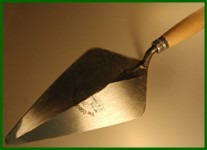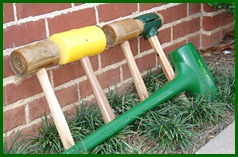Bricklayers’ Tools
An overview of materials, designs and specialty markets that are forging new tools for bricklayers
By Brett Martin
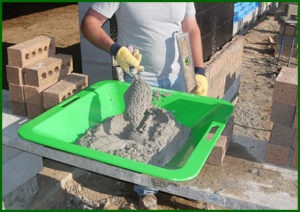
The latest and greatest tools for bricklayers provide more comfortable grips, increased performance and longer life spans. And, there’s more good news: New bricklayer tools also offer better safety features and ergonomics, which help prevent injuries.
“Anything we can do to prolong the longevity of the career of the mason or a tender is our goal,” says Shelly Carney, VP of GATORBACK in Lakeville, Minn.
Simple ideas deliver big results
Sometimes a basic idea leads to new tools that make bricklaying faster or easier. “With mortarpans, a simple change can make a big difference in how masons do their work,” Carney says.
Last fall, the company released its new mortarpan. Like the GATORBACK mortarboard, the mortarpan is made with a non-porous, copolymer material that won’t absorb moisture from mortar, keeping the mortar at optimum workability.
“Other pans are either steel or weaker polypropylene plastic,” Carney says. “These pans eventually bend and warp. GATORBACK mortarpans hold their shape.”
The 30- X 30-inch mortarpan is six inches deep and weighs 8 pounds. Ultra violet protection and hardening additives keep the pan from becoming brittle from sun exposure.
“We made the mortarpan easier to carry with reinforced handles embedded in the sides, and the ergonomic design helps ease the strain on your back when you carry one or more,” Carney says. “We reduced the angle of the pan to make it more mason friendly for getting the mortar in and out. There’s not as much twisting of the wrist while scooping out mortar.”
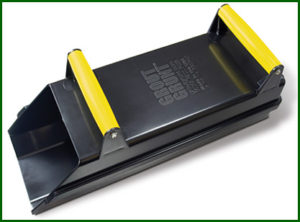
Morgan Agazzi, manager for Grout Grunt in Livonia, Mich., calls his company’s two-handled plastic scoop, which replaces a bucket for moving and placing grout or other high-density materials on walls, a “mousetrap idea” because of its simplicity.
The Grout Grunt provides a fast, ergonomic way to hand-deliver grout, Agazzi says.
“Insurance people are telling people to use it,” says Agazzi. “It helps eliminate insurance claims, because it’s ergonomically friendly. A full bucket of grout weighs almost 80 pounds. The Grout Grunt weighs 45 pounds with a half cubic foot of grout, and you can’t overfill it.”
Specialty tools for renovation
Baltimore-based Baltimore Toolworks Inc. makes tools for specific jobs, such as renovation work, says Downie McCarty, company president.
“For the renovation of old buildings, we’ve made several specialized joint chisels to clean out mortar,” McCarty explains. “If you use the right tools, you won’t tear up or mar the surface. There’s an increased demand for specialized tools for renovation.”
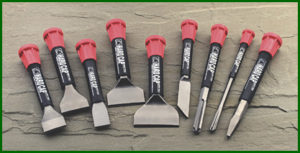
The company’s Hard Cap Safety Tool line, expanded to 34 tools, includes new joint chisels, brick sets and mason’s chisels. A polymer-coated head on the tools is two-and-one-half times larger than standard chisels, making them easy to strike while protecting the user’s hand, McCarty says.
“We developed the tools for safety, and what we found is that they’re 15 percent faster than standard cutting tools, because users have more confidence to strike the tool harder,” McCarty says. “The tools reduce 90 percent of the shock and vibration caused by hitting steel on steel, and they reduce noise by up to 30 percent.”
Trow & Holden Co. Inc. in Barre, Vt., also manufactures tools for restoration and mortar removal, including rippers, chisels and pneumatic carving tools.
There are several ways to remove mortar, such as saws or hammers and hand chisels, but the saws can damage the wall and create a lot of dust, says Lauren LaMorte, Trow & Holden’s VP. Pneumatic chisels give the user good control without creating a cloud of dust.
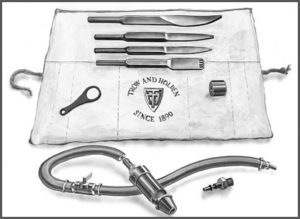
“Pneumatic tools have a lot less fatigue for the user,” she says. “Not only are you not swinging a hammer, which is fatiguing, air tools can remove mortar faster and with precision.”
Pneumatic chisels let the user remove mortar without damaging the surrounding brick or block. Trow & Holden’s new chisel retainer secures the chisel inside the pneumatic tool so it won’t fall out, yet it keeps the chisel loose and easy to control, LaMorte says. The rubber retainer loops onto the chisel and the air tool, and it’s easy to install and remove.
“Some masonry contractors like the chisel retainer, because they feel it’s safer,” LaMorte explains. “For guys working on scaffolding, it’s another peace of mind that they’re working safely.”
Change of materials for comfort, longevity
Breaking from traditional tool materials, such as wooden handles and carbon steel for jointers, has produced comfortable grips and tools that last longer. Kraft Tool Co., in Shawnee, Kan., is offering leather handles on its smaller brick trowels.
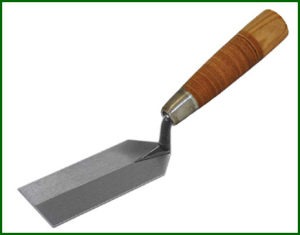
“The leather handles are more comfortable. Most brick masons are looking for something comfortable that still lets you get a firm grip,” says Steve Cook, sales and marketing manager for Kraft Tool. “Wood handles go through cycles where they get wet and then dry out. Over time, this will wear away the wood. The leather handles hold their shape and won’t get worn out.”
Leather handles are more impervious to hand perspiration, he says. Sweat can make wood handles slippery, but the leather handles dry out quickly without becoming slick.
The company has new jointing tools, including E-Jointers, that fit in a mason’s pocket, Cook says. The three- or four-sided jointers are available in varying thicknesses to get into different joint widths.
“You can use these jointers to get into unusual places, like corners and around windows,” he says.

Gibsonia, Pa.-based Bon Tool Co. is offering new stainless steel bricklayer’s tools, including bullhorn, convex brick and barrel jointers. John Wight, VP of sales and marketing for the company, says stainless steel has been a trend in tools over the last few years.
“Stainless steel tools are longer lasting and more wear resistant than straight carbon steel,” Wight says. “Because of their longevity, stainless steel tools are a better value for the money.”
The stainless steel jointers won’t rust and don’t need to be “broken in” like carbon steel tools, Wight says. “The stainless steel jointer creates a nice, smooth joint.”
|
Brett Martin is a Minneapolis-based freelance writer with 15 years of construction and writing experience.
